How Many Species Of Caimans Are There?
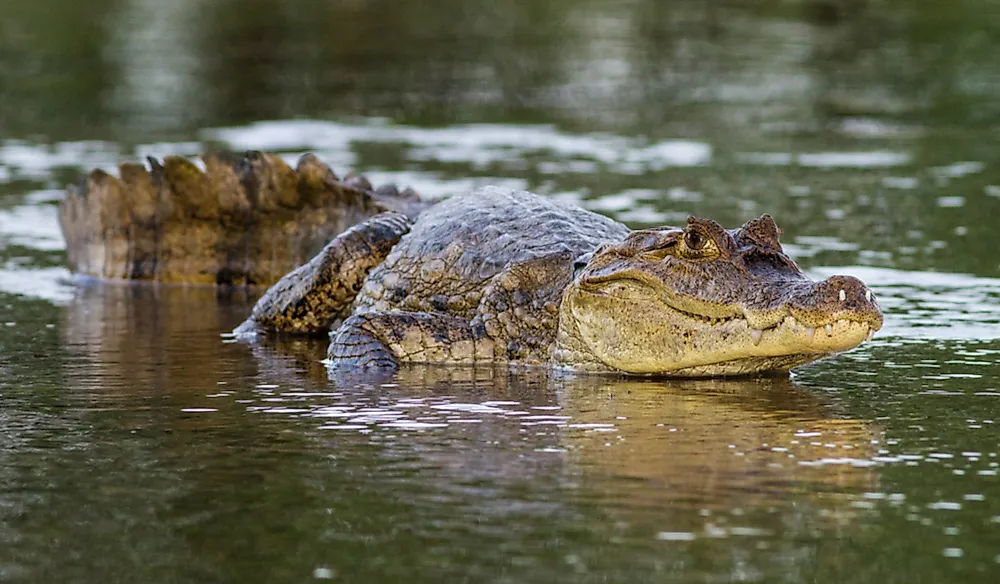
A caiman is an alligatorid crocodilian that is part of the Caimaninae subfamily, which is one of the two lineages of the family Alligatoridae. Caimans are small-sized crocodilians which inhabit mangrove rivers, swamps, marshes, and lakes of South and Central America. There are currently six different caiman species that are native to Central and South America, while several other species are now extinct. The black caiman is the world’s biggest caiman species, while Cuvier’s dwarf caiman is the smallest.
6. Cuvier's Dwarf Caiman
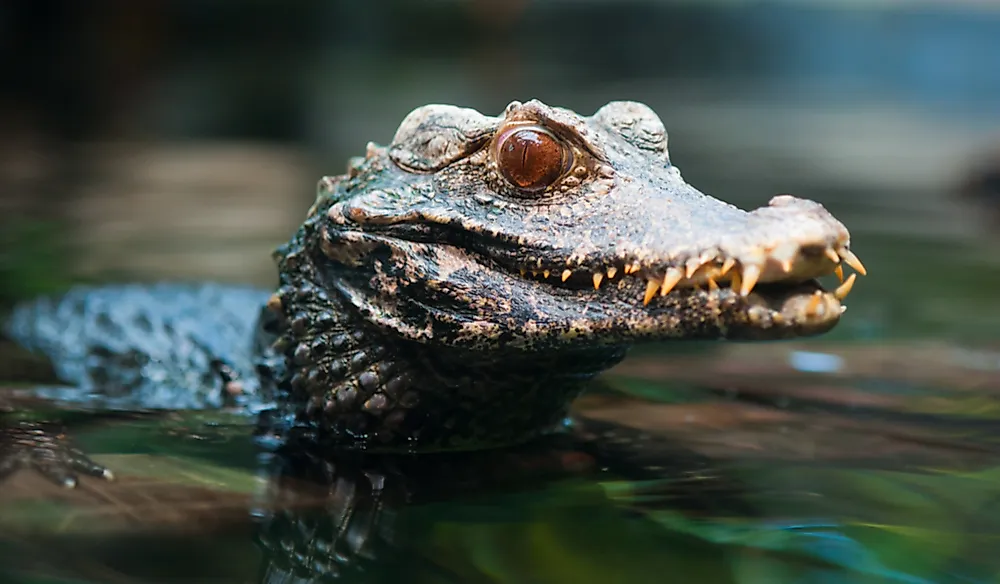
The Cuvier’s dwarf caiman, also known as the musky caiman, is a small caiman that inhabits Venezuela, Suriname, Peru, Paraguay, French Guiana, Guyana, Ecuador, Colombia, Brazil, and Bolivia. First described by French zoologist George Cuvier in 1807, the species resides in flooded forests near lakes, riverine forests, and near fast-flowing stream and rivers. The Cuvier’s dwarf caiman can survive in colder waters than other caimans, and are known as the wedge-head caiman in the pet trade. The female dwarf caiman can attain a maximum body length of about 3 feet 11 inches, while the male is approximately 5 feet 3 inches long. An adult dwarf caiman weighs between 13 pounds and 15 pounds, and has a strong armor on the ventral and dorsal parts of their bodies, which compensate for their small size especially in terms of defending against predators. The species has dermal scales with bony bases, and an unusually dome-shaped skull with short concave, smooth snouts. Young caimans are brown with some black stripes, while adults have a dark brown head and a dark brownish-black body. Adults feed on molluscs, shrimps, crabs, birds, small mammals, amphibians, and fish, while young Cuvier's dwarf caimans eat snails, frogs, tadpoles, crustaceans, and fish.
5. Smooth-Fronted Caiman
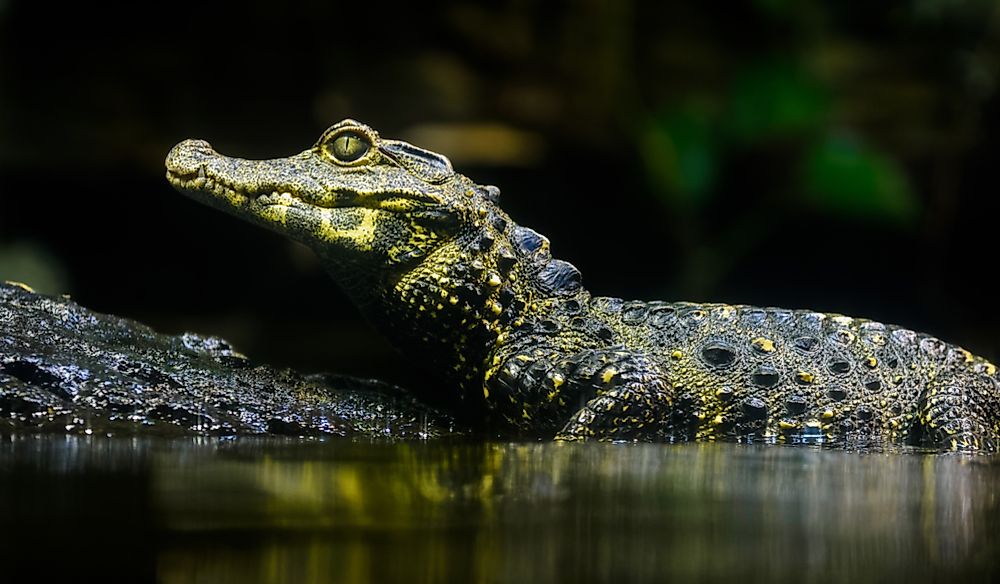
The smooth-fronted caiman, also known as Schneider’s dwarf caiman or Schneider's smooth-fronted caiman, is a South American crocodilian indigenous to the Amazon and Orinoco basins. It is the second-smallest caiman species, and inhabits parts of Venezuela, Guyana, Ecuador, Colombia, Brazil, and Bolivia. The smooth-fronted caiman resides in the smaller streams of forested regions, is rarely seen in open places, and does not bask under the sun, even when in captivity. Its head resembles a spectacled caiman’s head, but lacks the bony-ridge between its eyes. It has large, sharp, triangularly shaped scutes on the back of its tail and neck, and heavily ossified armor on its ventral and dorsal surfaces. The smooth-fronted caiman has a dark grayish-brown body with mid-brown colored eyes. The body length of females does not usually exceed 4 feet 7 inches, while the male is about 7 feet 7 inches long. Males are bigger than the females, and typically weigh about 79 pounds. The smooth-fronted caiman is a strong crocodilian relative to its size.
4. Yacare Caiman
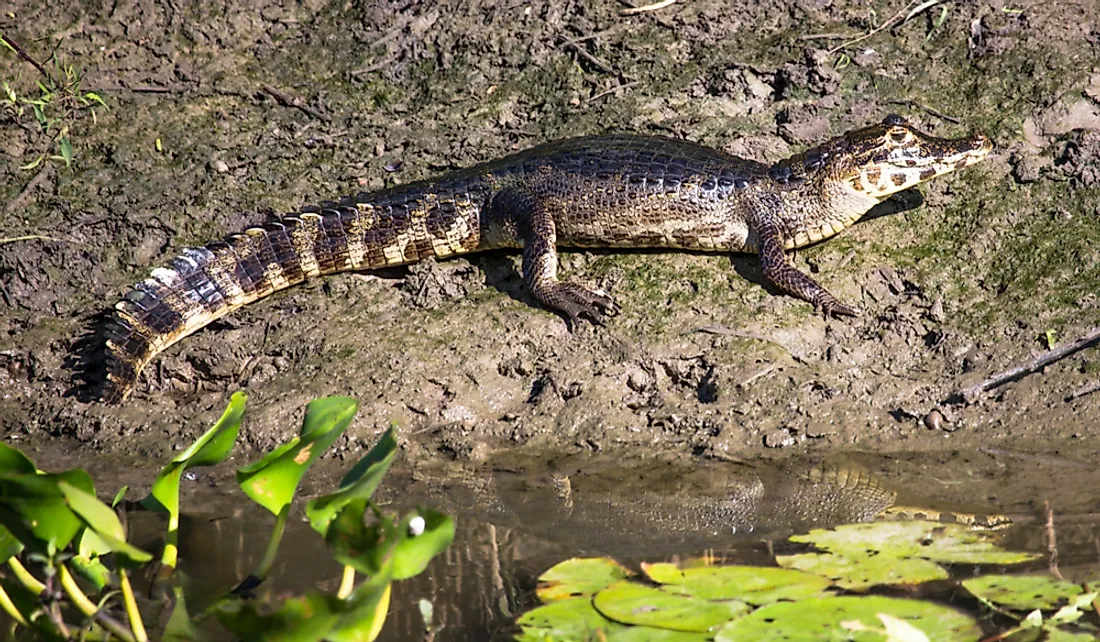
The yacare caiman is a species of caiman indigenous to the central parts of South America, including southwest and central Brazil, eastern Bolivia, southeastern Peru, Uruguay, northeastern Argentina, and Paraguay. There are over 10 million yacare caimans in the Brazilian Pantanal, which represents the world’s biggest single crocodilian population. The yacare caiman feeds primarily on fish, particularly piranhas, as well as small mammals, reptiles and birds. Larger adults can feed on bigger mammals. Adult female caimans have an average length of about 4.6 feet, while males are about 8.2 feet long. The body weight of females in approximately 51 pounds, while males weigh about 128 pounds. The caiman's small body size makes them potential prey for anaconda and jaguars, and are generally not considered to pose a threat to humans.
3. Spectacled Caiman
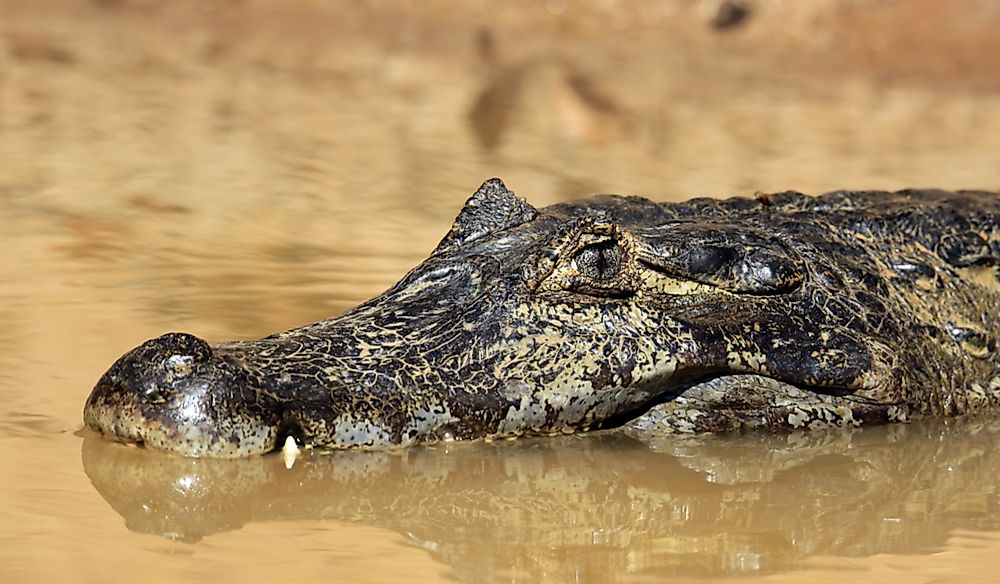
The spectacled caiman, also known as the common caiman or white caiman, is a crocodilian reptile that inhabits both South and Central America. The species resides in riverine and lowland wetland habitats, and can tolerate both fresh and salt water. The spectacled caiman is the most common crocodilian species in the world. Larger spectacled caimans feed on water snails and fish, while medium and small caimans eat molluscs, crustaceans, and insects. They are considered small-to-medium sized caimans, as females are 4.6 feet long, while males have a maximum length of about 6.6 feet. The body weight of an adult spectacled caiman ranges from 15 to 88 pounds. The largest females weigh approximately 44 pounds and have a length of over 5.3 feet. Spectacled caimans in Venezuela are larger than those in Mexico. The species has a gray-green body, and is known to change color, as the black pigment in its skin cells expands during the cold seasons, making it darker.
2. Broad-Snouted Caiman
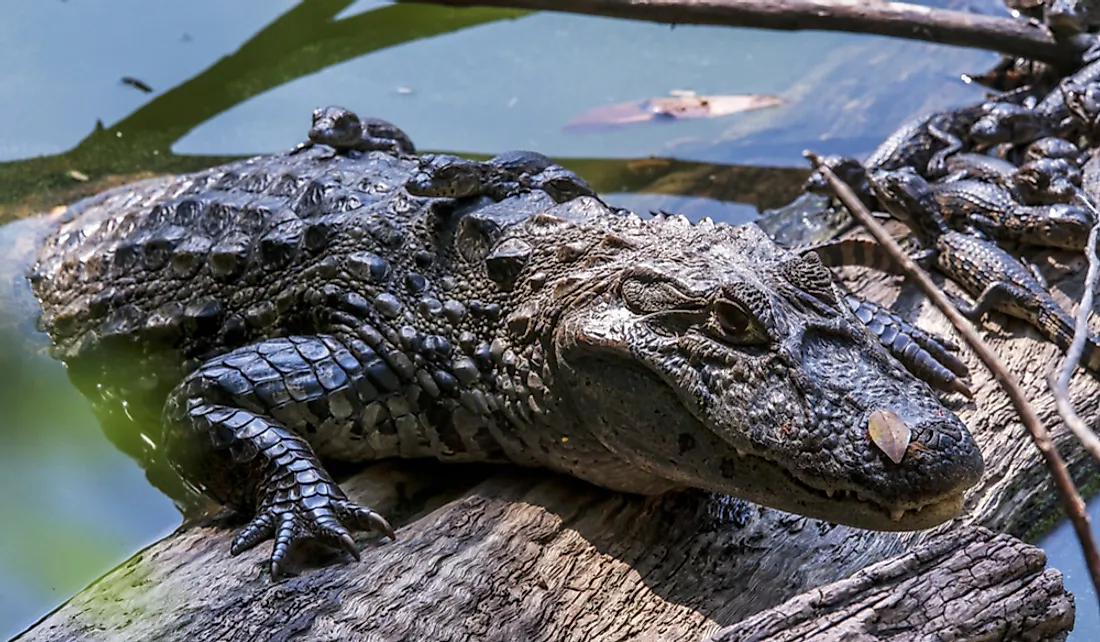
The broad-snouted caiman is a crocodilian reptile that inhabits east and central South America, particularly Bolivia, Paraguay, northern Argentina, Brazil, and Uruguay. The species lives in freshwater swamps and marshes, especially in slow-moving or still waters. It is an exothermic species which depends on the environment to regulate its temperature. The diet of young broad-snouted caimans consists of insects, while adults feed on small reptiles, fish, and birds. Adult broad-snouted caimans usually have an average length of about 8.2 feet in the wild, although some older males have been recorded at 11 feet long. The species weighs between 64 pounds to 137 pounds. The broad-snouted caiman is light olive-green in color, and some individuals have numerous spots on the face. They have broad snouts, which have been adapted for ripping through dense vegetation.
1. Black Caiman
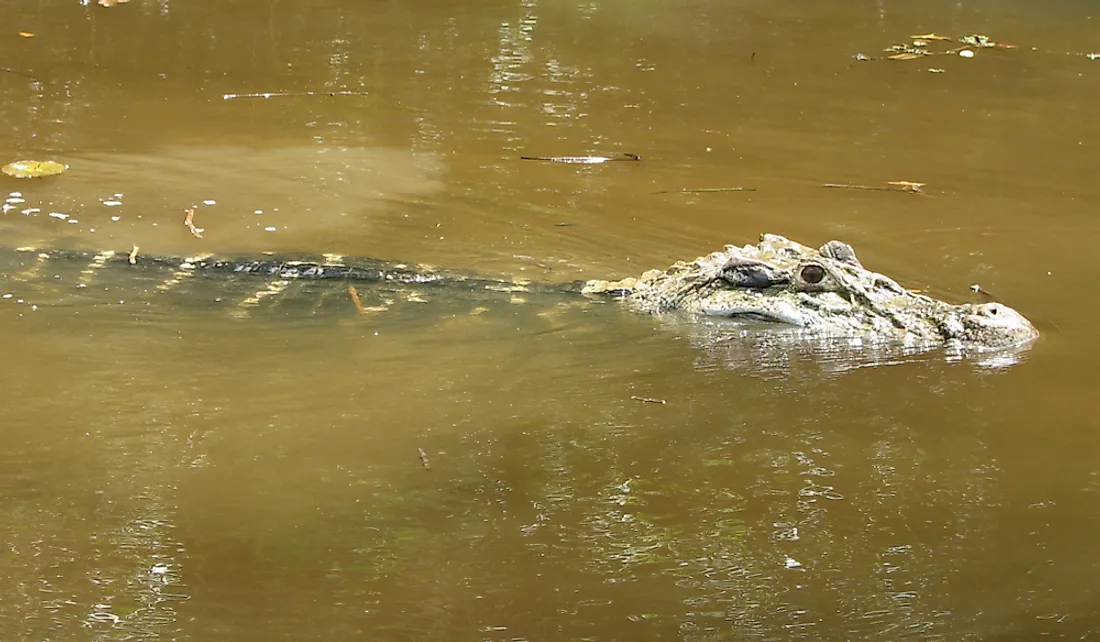
The black caiman is the biggest crocodilian species, and together with the American alligator, is one of the biggest members of the family Alligatoridae and order crocodilian. It is a carnivorous reptile that resides in the slow-moving rivers and freshwater habitats of South America. The black caiman is dark in color, and some individuals can appear black with brown to gray branding on the lower jaw. Young black caimans have vibrant coloring, with pale yellow to white brandings on their flanks, while adults have a dark scaly skin which helps them regulate their body temperature by absorbing heat. Adult black caimans are about 14 feet 1 inch long, although some older males have reached a length of 16 feet 5 inches. An average-sized female black caiman is about 9 feet 2 inches long. Larger males weigh over 1,100 pounds, while the mid-sized males weigh about 660 pounds. Their skull morphology varies with gender and age, meaning that males have a stronger bite force and can exploit larger prey than females. Young black caimans can be differentiated from spectacled caimans by their large heads and the color of their lower jaw.











